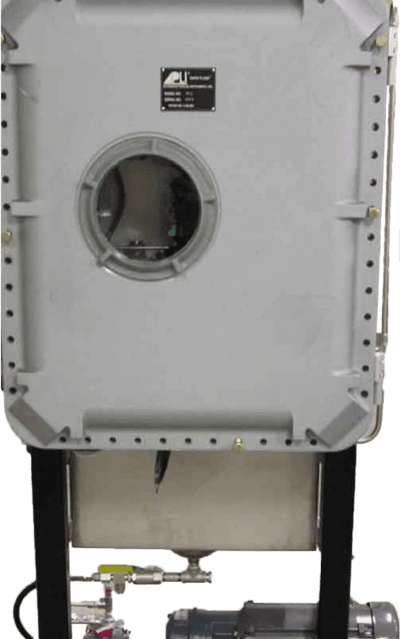RF3 Rapid Flash System
Price
Request a Quote
Stock
In Stock
Description
The Rapid Flash is a microprocessor-based flash point monitoring system. It provides pipeline operations personnel with the capability of automatic product flash point monitoring. The unit can be used locally or remotely for batch interface cutting or transmix injection. Deviations in product flashpoints can be monitored with user-programmable high and low alarm setpoints. Out-of-spec sections of a batch, which would normally reduce the overall quality of the batch, can then be cut out.
The system requires approximately 30 seconds to perform a flashpoint reading with a programmable delay between readings from 0 to 9999 seconds. The flashpoint is determined by drawing air through a product sample chamber to develop a gas vapor. This vapor is then passed through a sensor chamber that measures the product’s lower explosive limit (L.E.L.). The sample temperature, L.E.L., and API gravity (API gravity must be supplied to the Rapid Flash as a 4-20 may signal) are then used to calculate the product flashpoint.
The system is currently tested for measuring various grades of fuel oil, kerosene, and Type A jet fuel. The flashpoint reading is supplied as a 4-20 mA output signal (scaled 0-250 F or 0-200 F) and can also be displayed on a laptop or tablet computer, either locally at the unit or remotely at the control room. A laptop or tablet computer can also be used to monitor the system operation, configure the system or troubleshoot problems.
Features- Automatic shutdown and startup with a user supplied status input
- Automatic shutdown and startup on product that is out of sensor range (gasolines, etc.)
- Redundant sensors with autozero and automatic switchover are now a standard feature
- Alarm output on system malfunction
- Remote access via Ethernet or optional WiFi
- Event and alarm logging
- Flash point and gravity trending
- Touch screen computer included for monitoring, diagnostics, and configuration
- These features and many more make the Rapid Flash a valuable component in the overall scheme of pipeline automation
Specifications
Specifications
Brand
Mounting Frame
- 30" L x 75" H x 24" W (Base)
Enclosure
- 24" x 30" x 8"
Weight
- 850 lb
Sample Volume
- 1 Per Flash Cycle (75-100 ml Approx.) Varies With Line Purge Time
Inlet
- 1/4" Stainless Steel Tubing
Drain
- 1/2" Stainless Steel Tubing
Working Pressure
- 10 to 1,500 psi
Sample Filtration
- 140 micron T-type Filter Supplied 100 mesh Filter Supplied (If Needed)
Analog Input
- Gravity 4-20 mA (2 Conductors Shielded) Default 20-70 (User Ccaled) Linear or Non-linear Scale (User Selectable)
Analog Output
- Flash Point 4-20 ma (2 conductors shielded) Scaled 0-200 or 0 F. (user selectable)
Status Output
- Malfunction Alarm (Dry Contact) 100 Vdc / 130 Vac 0.5 A Max.
- Setpoint Alarm (Dry Contact) 100 Vdc / 130 Vac 0.5 A Max.
- Alert / Service Needed Alarm (Dry Contact) 100 Vdc / 130 Vac 0.5 A Max.
Status Input
- Line Flow Status 24 Vdc (External Dry Contact Closure req.) Oil / Kero Select 24 Vdc (Optional External Dry Contact Closure)
Input Voltage
- 115 Vac 50/60 Hz
Input Current
- 5 A
Communication
- Ethernet Connection
- Optional Wi-Fi Available for Rremote Monitoring, Configuration, and Diagnostics

